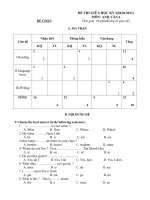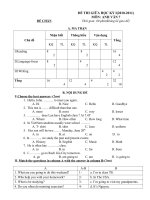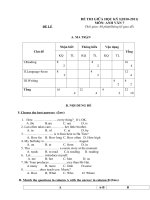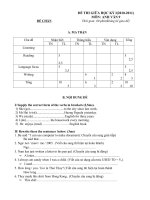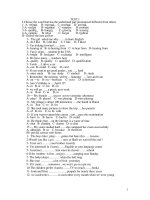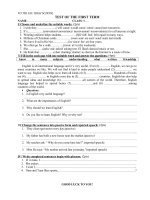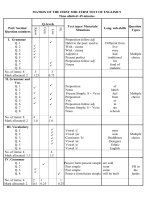Unit 7 bộ đề tự kiểm tra 4 kỹ năng tiếng anh 9 tập 2 (lê thị hồng phúc nguyễn thanh hương)
Bạn đang xem bản rút gọn của tài liệu. Xem và tải ngay bản đầy đủ của tài liệu tại đây (552.81 KB, 10 trang )
Unit
7
Recipes and
Eating Habits
A. PHONETICS
I Find the word which has a different sound in the underlined part.
1. A. second
B. welcome
C. collection
D. improve
2. A. other
B. colourful
C. dolphin
D. wonderful
3. A. food
B. took
C. cook
D. look
4. A. fun
B. uncle
C. club
D. aquarium
5. A. clever
B. circus
C. collect
D. cushion
II Find the word which has a different stress pattern from the others.
1. A. generous
B. suspicious
C. constancy
D. sympathy
2. A. acquaintance
B. unselfish
C. attraction
D. humorous
3. A. loyalty
B. success
C. incapable
D. sincere
4. A. carefully
B. correctly
C. seriously
D. personally
5. A. excited
B. interested
C. confident
D. memorable
B. VOCABULARY AND GRAMMAR
III Write the nouns about food and drinks given in the box below next to the suitable
quantifiers.
cake
wine
apple juice
grapes
champagne
wine
cauliflower
chocolate
honey
soda
noodles
fruits
flour
bread
salt
garlic
coffee
celery
beans
milk
1. a piece of .......................
11. a slice of .......................
2. a glass of .......................
12. a pinch of .......................
3. a bottle of .......................
13. a handful of .......................
4. a bowl of .......................
14. a clove of .......................
5. a bar of .......................
15. a spoonful of .......................
6. a can of .......................
16. a mug of .......................
7. a carton of .......................
17. a barrel of .......................
8. a basket of .......................
18. a sip of .......................
9. a bunch of .......................
19. a stick of .......................
10. a bag of .......................
20. a head of .......................
IV Find one verb about food preparation for each definition below.
Verb
Definitions
1. ..................... to mix the food very well using the blender
2. ..................... to cut into thin pieces
3. ..................... to move the food with a circular movement of the spoon
4. ..................... to take off the skin
5. ..................... to put two or more different things together
6. ..................... to remove the water from something (for example, pasta)
7. ..................... to cut into small pieces
8. ..................... to soak meat in a mixture of spices and seasonings
9. ..................... to leave something in water
Now write a verb you have found under each photo below.
A. ...........................
B. ...........................
C. ...........................
D. ...........................
E. ...........................
F. ...........................
G. ...........................
H. ...........................
V Choose the best answer A, B, C or D.
I. ...........................
1. What would you like to buy, sir? – A ................. of tuna, please.
A. tin
B. can
C. box
D. carton
2. Yesterday I saw her carrying a ................. of apples out of the supermarket.
A. packet
B. bag
C. box
D. load
3. If you don’t want to go out tonight, you ................. stay at home to watch TV.
A. might
B. should
C. may
D. can
4. You ................. at least call or send him a message to ask for his permission if you
want to use his car.
A. should
B. may
C. might
D. can
5. Most people know that yogurt is very good for ................. .
A. kidney
B. digestion
C. psychology
D. blood circulation
6. Excessive intake of fat will increase the risk of suffering from ................. .
A. sleeplessness
B. eating disorders
C. obesity
D. cancer
7. Fast food is not a healthy food because it contains a lot of artificial flavors and ...........
A. preserve
B. preservation
C. preservative
D. preservatives
8. Artificial flavors are ................. designed to mimic the taste of natural ingredients.
A. addition
B. additions
C. additive
D. additives
9. ................. products include food items such as yogurt, cheese, and butter.
A. Natural
B. Artificial
C. Diary
D. Non-diary
10. Flavor ................. are added to our favorite processed foods, restaurant meals and
snacks for their better tastes.
A. providers
B. enhancers
C. boosters
D. supporters
VI Choose can, must, may, might or should to fill in the blank.
1. If you don’t want to miss the last bus of the day, you .................... go to the bus top
immediately.
2. If you don’t feel well enough for the walk, you ................ stay at home and take a rest.
3. If you think this T-shirt is overpriced, you .................... not buy it.
4. My parents are very strict. I .................... ask for their permission if I want to go out in
the evening.
5. If you have completed your homework, you .................... watch TV or play computer
games in one hour.
6. If you want your drink to be cooler, you .................... need to add some more ice.
7. If you want to see her during office hour, you .................... call to inform her in
advance, I think.
8. If no one answers the doorbell, they .................... not be at home now.
VII Fill in the blank with the correct form of the given word.
1. The slice of pork was ............................, so she refused to eat it. She
was afraid of having a stomachache.
2. In spite of his ............................, he ignored all the delicious food
served on the table.
3. Eating a lot of fast food can do ............................ to your health.
4. Jenny is feeling sick. She thinks that she is having a problem with
her ............................ .
5. Eating ............................ without being treated possibly cause a
number of long-term problems for your health.
VIII Find one mistake in each sentence and correct it.
order
hungry
harmful
digest
order
1. If you do not have breakfast in the morning, you should not be able to
....................
A
B
C
study or work efficiently.
D
2. I don’t like eating something overcooked, so I will ask the chef to cook ....................
A
B
C
another piece of beef for me.
D
3. My mother needed some cloves of garlic, so I went to the market and
.....................
A
B
C
buy it for her.
D
4. While the chicken is cooking, wash two cucumbers, chop them in
.....................
A
B
C
a half and slice them.
D
5. If you can cook some food for yourself, have a bowl of cereal and a
.....................
A
B
C
D
bottle of milk.
C. READING
IX Read the passage. Fill in the blank with one word, based on the beginning letter(s).
Why Detox?
Your body can accumulate toxins for many years without complaining, but
eventually when your organs and vital systems can no (1) l.................... cope, the body
starts to rebel. And it is at this point of personal overload that you will (2)
ex.................... diseases. This is when you cannot ignore the warning signs any longer.
What starts out as frequent coughs and colds or regular headaches, if paid no (3)
at...................., can progress to a louder, more serious complaint – and perhaps now
you have (4) de.................... high blood pressure, high cholesterol, arthritis or diabetes.
There are so many ways our bodies can become overloaded; toxins can accumulate
through what we eat and drink, the air we breathe, what we put on our skin; and even
by the way we think! Although the human body is designed to eliminate (5)
t...................., it can quickly become clogged up, leading to toxins becoming stored in
the cells and joints. Ultimately this (6) r.................... the body’s ability to function
properly and to heal itself.
The process of a well-managed fasting and detoxification program (7)
h.................... to release and eliminate unwanted toxins in a safe way. Detox supports
and allows the body to heal itself, fasting is nature’s medicine; cleansing and repairing
at deep cellular level with the result that seemingly unrelated health (8) p....................
often disappear for good.
X Read the passage.
Decide if the statements are true (T) or false (F).
11
1. You can save money by buying organic food in the supermarkets.
..................
2. Non-organic products are, in fact, always more expensive than
organic equivalents.
..................
3. You need to prioritize your purchases when you don’t have a lot of
money.
..................
4. Organic food consumers can often get special discounts.
5. People who like organic food may care about environment protection. ..................
Buying organic produce
Organic food is the cheapest when bought directly from a farmer or producer, either
via a box scheme, farmers market or farm shop. Buying local, organic food will often
cost less than the non-organic equivalent. Unfortunately, most of us cannot access
organic food directly from the producer, and therefore it tends to be more expensive than
the basic non-organic equivalent in the supermarkets. It does pay to shops around. Some
organic products cost less than premium non-organic products. You might be pleasantly
surprised.
If you are on a tight budget, but would like to buy more organic food, then you
could try prioritising your purchases. Items such as organic flour, milk, bread and butter
can be cheaper. If you compare prices, you may actually find that many organic brands
are cheaper than their conventional equivalents and are often on special offer.
There are other reasons, besides nutrition, that people choose organic food - such
as taste, to avoid pesticides and a concern for the environment. The organic movement
does promote better soil and it stands to reason that in the long run, organic farming is
better for overall soil quality. Let’s not forget the most important factor in your diet, as
far as fruit and vegetables are concerned, is to eat as much and as wide variety as
possible.
Find a word/ phrase in the reading that means:
21
1. a thing that is equal to or corresponds with another
..........................................
in value, amount, function, meaning (paragraph 1)
2. very little money to spare (paragraph 2)
..........................................
3. a substance used for destroying insects or other
..........................................
organisms harmful to cultivated plants or to animals
(paragraph 3)
4. support, actively encourage or improve (paragraph 3)
..........................................
5. over or after a long period of time (paragraph 3)
..........................................
D. SPEAKING
XI Read all the sentences below and guess your partners’ answers to the True/ False
questions below.
1. My partner can eat with knives and forks.
T/F
2. My partner thinks fast food is bad for health.
T/F
3. My partner is a fussy eater.
T/F
4. My partner is addicted to chocolate.
7/ F
5. My partner didn’t like green vegetables when she/he was a child.
7/ F
6. My partner hates people who chew chewing gum.
7/ F
7. My partner is allergic to seafood.
7/ F
8. My partner likes spicy food.
7/ F
9. My partner thinks it is wrong to eat between meals.
T/F
10. My partner likes to eat what his/her mother cooks.
7/ F
Now work in pairs.
Ask your partner to see whether your guesses are correct or not.
Expand your conversations with the interesting information from him/ her.
XII Work in groups of 3-4. Each person tells about his/ her fast food eating habits.
You should base on some suggestions below:
- Do you like eating fast food?
- How often do you eat fast food?
- What kinds of fast food do you often eat?
- How much money do you often spend on fast food per month?
- Do you think it is good or bad to eat fast food frequently?
E. LISTENING
XIII Answer the questions below.
1. Do you like instant noodles? Why?
2. How often do you eat it?
3. Do you know anything about the history of instant noodles?
4. Do you think it is a healthy food?
5. Is it popular in Vietnam?
XIV 1. Listen to a man talking about instant noodles. Decide if the statements below
are true (T) or false (F).
1. Instant noodles are among the best things in Japan.
..................
2. Instant noodles appeared in the 19th century.
..................
3. Momofuku Ando didn’t succeed in making noodles immediately.
..................
4. Ando’s cup instant noodles was born after Ando saw the Americans
..................
eating them.
5. Cup instant noodles were liked by many people then.
..................
2. Listen again and fill in the gaps with the missing numbers.
1. The history of instant noodles begins in Japan in ...................
2. Momofuku was ................... years old at that time.
3. For ...................year, he tried to make instant noodles, and he succeeded.
4
................... years later, he went to America.
5. In ..................., he made instant noodles in a cup.
6. Ando died in ...................
F. WRITING
XV Complete the following sentences, using modal auxiliary verbs (can, must, may,
might, should, etc.)
1. If you are afraid of gaining weight, ................................................................................
2. If she wants her skin to be more beautiful, .....................................................................
3. If he wants to strengthen his muscles, ............................................................................
4. If the boy drinks a lot of soda, ........................................................................................
5. If you don’t want to have stomachache, .........................................................................
6. If the food is served when it is hot, .................................................................................
7. If you want to add some flavors to the cake, ..................................................................
8. If your daughter gets addicted to chocolate, ...................................................................
9. If you eat too late, ...........................................................................................................
10. If Dad likes to eat spicy food, .........................................................................................
XVI Write an email (100-120 words) to your grandmother who lives far from you. Tell
her about your recent eating habits.
You should base on some suggestions below:
- What do you often have for breakfast? for lunch? for dinner?
- What are your favorite foods and drinks?
- By whom in your family do you like foods are cooked?
- Do you and your family often eat out or eat fast food?
- Do you think you have good eating habits or not? Why?
- Do you have any eating problems? If yes, do you need her advice?
Dear ........................,
................................................................................................................................................
................................................................................................................................................
................................................................................................................................................
................................................................................................................................................
................................................................................................................................................
................................................................................................................................................
................................................................................................................................................
................................................................................................................................................
................................................................................................................................................
................................................................................................................................................
................................................................................................................................................
................................................................................................................................................
................................................................................................................................................
................................................................................................................................................
................................................................................................................................................
................................................................................................................................................
................................................................................................................................................
................................................................................................................................................
................................................................................................................................................
................................................................................................................................................
Love,
...........................(Your signature)
